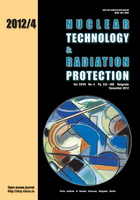
232Th, 226Ra, AND 40K ACTIVITIES AND ASSOCIATED RADIOLOGICAL HAZARDS IN BUILDING MATERIALS OF ISLAMABAD CAPITAL TERRITORY, PAKISTAN

Vol.
XXVII, No. 4, Pp. 333-408
December 2012
UDC 621.039+614.876:504.06
ISSN 1451-3994
Pages: 392-398
Authors: Saeed U. Rahman and Muhammad Rafique
Abstract
Radioactivity levels in building materials, collected from the Islamabad capital territory have been determined by using a gamma spectrometric technique. Measured specific activities of 226Ra, 232Th, and 40K in material samples ranged from 8 ± 1 to 116 ± 6 Bq/kg, 9 ± 1 to 152 ±5 Bq/kg, and 29 ± 6 to 974 ± 23 Bq/kg, respectively. The radium equivalent activity, absorbed dose rate, annual effective dose, and gamma index were evaluated from the measured amounts of radioactivity to assess the radiation hazard associated with the studied building materials. The mean radium equivalent activity, the absorbed dose rate and annual effective dose estimated ranged from 81 ± 6 to 221 ± 11 Bq/kg, 38 ± 3 to 104 ± 5 nGy/h, and 0.23±0.02 to 0.64 ± 0.03 mSv, respectively. The ranges of the calculated Raeq were found to be lower than the values recommended for construction materials (370 Bq/kg). The mean values of the internal and external hazard indices were found in the range of 0.30 ± 0.02 to 0.78 ± 0.05 and 0.22 ± 0.02 to 0.60 ± 0.03, respectively. The results of the materials examined indicate no significant radiological hazards arise from using such material in building construction.
Key words: building material, radioactivity, gamma spectrometry, radiological hazard, annual effective dose
FULL PAPER IN PDF FORMAT (273 KB)